Olympus PEN E-P1 Review
Olympus PEN E-P1 Introduction
The Olympus E-P1 is an interchangeable lens digital camera. It uses a Four-Thirds sensor along with the Micro Four-Thirds lens mount. This is now the second such camera with a compact design similar to the reviewed Panasonic Lumix GF1.
The Olympus EP-1 is built around a 12 MP sensor with ISO sensitivity range from 100 to 6400 and both built-in stabilization and built-in dust-reduction. Despite the compact design, it is built as an advanced photographic tool, complete with dual control-dials, full-manual controls, a hot-shoe and a highly customizable interface. Like all Micro-Four Thirds camera, the EP-1cannot feature an optical reflex viewfinder but instead uses Live-View on a 3" LCD. It is possible for a fixed-focal-length (17mm only at this time) optical-tunnel viewfinder to be placed on the hot-shoe for coarse framing with a corresponding lens.
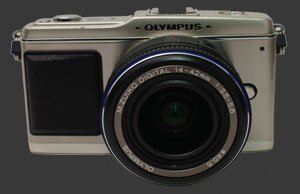
Olympus PEN E-P1 Usability - How easy is it to use?
The EP-1 is relatively compact compared to most cameras with interchangeable lenses, otherwise known as DSLRs, but is larger than what one could call a compact camera. It fits somewhere between a medium camera and a classic ultra-zoom. There is enough space next to the lens-mount for a cramped but reasonable grip.The camera is curved outwards on both side of the grip to ensure a secure hold on the camera.
Eyelets are provided for a next-strap but it seems a hand-grip is more suitable to complement the discretion offered by a camera of this size. Just like the Panasonic Lumix DMC-GF1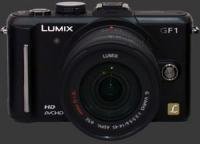
Panasonic Lumix DMC-GF1, this digital camera has its shutter-release located on the top-plate. Since the strap eyelets are on the sides, the index finger rubs against the strap the reach the shutter-release. Things are slightly better though than the Lumix GF1 since the eyelets move slightly. Without anything attached to the eyelets, reaching the shutter is not uncomfortable. The EC button suffers from the same placement problem.
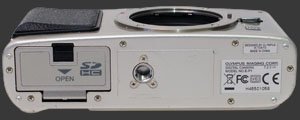
The camera itself looks and feels like it was built from the remains of a tank. Its metallic exterior feels very solid and it has a confidence-inspiring weight. A plastic molded-like-leather forms a handgrip and angle and curves complete the retro look, which is not for everyone. The tripod mount is not inline with the lens center and the connector does is found on the grip-side of the camera.
The camera rear is dominated by the 3" LCD screen. What is not covered by the LCD is covered by buttons and dials. There are 6 stand-alone buttons, one 4-way controller with a central button and a slim dial around it, and a second dial which is vertically mounted. A small speaker marks where the thumb rests. Also accessible from the rear is the mode-dial which one reads on the camera's top. The remaining controls are all on the top-plate with the power button, the shutter-release and exposure-compensation buttons completing the set. There is also a hot-shoe just above the lens. Note that the EP-1 lacks a built-in flash.
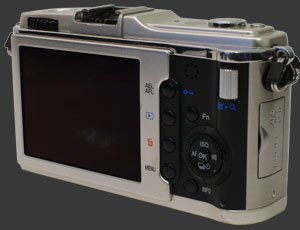
The LCD display is a bit lack-luster considering it is the only viewfinder on the camera. The display is bright with an anti-reflective coating but not enough to prevent bright light to wash it out. It has 230K pixels which is the norm on most compact cameras. There is a slight but perceptible lag to the LCD. The display is also not exposure-priority nor does it show the correct white-balance, which is very disappointing considering these are the corner-stones, along with 100% coverage which it does have, of live-view. Interestingly, M mode is exposure-priority at least.
The odd control-dials actually work well with the exception of using the lower one with gloves on, which is going to be a recurring theme lately as these reviews are being done during the Canadian winter. The remaining buttons are placed within reasonable reach of the thumb. The arrows on the 4-way controller give quick-access to ISO, WB, drive and AF modes.
Navigating the lengthy menu system is straight-forwards but finding settings is not as it is quite disorganized. The main camera tabs include some useful and seldom used functions while the settings menu includes both image settings and customization options. A few options are oddly named, making the camera manual essential for understanding the camera. One does appreciate though the incredible amount of customization possible on the Olympus E-P1. The dials can be assigned in terms of functions and direction. Even the focus ring direction can be set, thanks of the fly-by-wire mechanism built into Micro Four-Thirds and Four-Thirds lenses. The AE-L button can be customized by focus-mode, which is great for making it work well. A function button can be assigned to a number of functions including the ultra-efficient one-touch custom white-balance feature. Another really great setting controls which Info displays are cycled through in both live-view and playback mode. This is a rarely seen time-saving feature which avoids having to cycle through unwanted display screens. A separate option enables the display of the 2-axis digital level built into the EP-1. Both long shutter and high-ISO noise reduction are customizable and can be turned off.
Olympus E-P1 and E-620 with 14-42mm F3.5-5.6 Lenses

Olympus PEN E-P1 Performance - How well does it take pictures?
The intention of a camera such as the Olympus E-P1 is to stay flexible, produce high quality images and be as small as possible. In this goal the E-P1 excels, showing superb image quality with high details and low image noise. This one even compares very well to larger-sensor DSLRs, a feat which escaped the Panasonic GF1 which supposedly uses the same sensor, although processing and the anti-alias filter are certainly different.

Color accuracy is generally good. Even automatic white-balance is above average, although the camera does not always show it in the viewfinder preview. There is some flexibility in color rendition with the Natural setting showing the most accurate results. Sharpness is also good with a +1 setting adding little artifacts while producing a sharper image.
Exposure is very good on the E-P1. Both over and under exposure do happen but usually by a small amount and not often at that. The LCD is sometimes misleading again here as its low contrast may clip too early. Dynamic range is actually good for a camera this size and compares well to that of an entry-level DSLR.

Image noise is kept low without much noise-reduction. As with most DSLRs, details are good and there is little noise to be seen until ISO 800. Some noise is visible at ISO 800 but it only starts disturbing at ISO 1600. ISO 3200 is noisy but a small print is possible. ISO 6400 is even more noisy but still produces recognizable subjects. Sharpness on an interchangeable lens camera like this one depends on the lens used. Same thing goes for distortion and vignetting. As the E-P1 has a weak anti-alias filter, it is more lively to become lens-limited than sensor limited, meaning that an investment in higher-quality lenses will pay off.
Speed is arguably the most important weakness of small cameras. A great deal of slowness is usually attributed to the contrast-detect autofocus system and the Olympus E-P1 is an example of this. It easily takes 1s or more to lock focus. This is clearly the most significant weakness of this digital camera. While the continuous drive is fast and goes on until the card is full, the LCD display lag is enormous, making following moving subjects impossible.
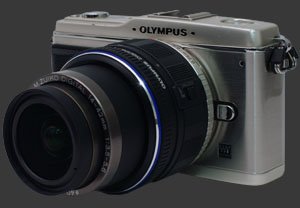
The time to power on is a little long, just over 1s. Power-off takes under one second though. Most other functions are quick to respond. This digital camera is shooting-priority and resumes very fast. Playback mode is really fast with only scrolling at low magnification being slower. Lenses are zoomed mechanically, so that is as fast as you can do it and completely precise. Any way we compare, battery-life is short. The E-P1 is quoted at 300 shots-per-charge. This is lower than all but the smallest cameras.
Olympus PEN E-P1 Conclusion
There are virtually no similar cameras, so one has to consider the compromise in choosing the Olympus E-P1. The good news is that image quality is not an issue for all but the most critical output. Portability is good considering the flexibility of interchangeable lenses. The camera and its lenses are still large enough to require an camera bag but the size of the E-P1 is suitable for more discrete and candid photography than a DSLR. The most significant downside of the E-P1 is its slow autofocus performance which makes it not suitable for moving subjects.
The last factor to consider is versatility. In that regard, the Micro Four-Thirds mount is designed for compatibility with new Micro Four-Thirds lenses and existing Four-Thirds ones as well. Few such lenses exist, but this is bound to change. Olympus' Zuiko lenses are legendary and many of them unique to the Four-Thirds format. Also because of the short back-focus distance of Micro Four-Thirds, more adapters can be made to this mount than possibly any other existing mount.
 |
Please Support Neocamera
All information on Neocamera is provided free of charge yet running this website is a huge endeavor. Purchases made via affiliate links found throughout the site help keep it running and up-to-date. There is no additional cost to you, so please consider buying via these links to our affilates:
If you found any information on this site valuable and did not purchase via our affiliate links, please considering donating via PayPal:
Any amount will be greatly appreaciated. Thank you for your support!
Olympus E-P1 Highlights
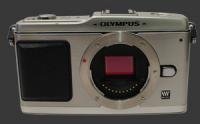
Sensor-Size: 17 x 13mm

Actual size when viewed at 100 DPI
| 12 Megapixels Mirrorless | ISO 100-6400 |
| Micro Four-Thirds Mount 2X FLM | Shutter 1/4000-60s |
| 2-Axis Built-in Stabilization | Full manual controls, including Manual Focus |
| 2 Axis Digital Level | Custom white-balance with 2 axis fine-tuning |
| Built-in Dust Reduction | Spot-Metering |
| 3 FPS Drive, 12 Images | Hot-Shoe |
| 1280x720 @ 30 FPS Video Recording | Lithium-Ion Battery |
| 3" LCD 230K Pixels | Secure Digital High Capacity |
Updates
2025.01.18

Fujifilm GFX 2025 Lens Roundup
Lens Review roundup of Fujifilm GFX Medium-Format lenses. Quality, performance and handling of the GF20-35mm F/4R WR, GF30mm F/3.5 Tilt-Shift and the GF55mm F/1.7.
2024.11.18

Best 2024 Photography Gifts for Every Budget
Great gifts for photographers and photo enthusiasts selected for every budget among the best products of 2024.
2024.08.07

Eye Protection Tips for Professional Photographers
The four main considerations for professional photographers regarding eyewear.
2024.07.14

Fujifilm X100VI Review
Flagship fixed-lens compact digital camera with a 40 MP sensor and Image-Stabilization, a first for the series. Retro design featuring dual control-dials, plus direct ISO, Shutter-Speed and EC dials. Its hybrid viewfinder can switch between EVF and OVF mode.
2024.05.09

Fujifilm GFX100 II Review
Flagship 102 Megapixels Medium-Format Mirrorless Digital Camera with 8-Stop 5-Axis IBIS, 8 FPS Drive, 8K Video and 400 MP Super-Resolution capture in a weatherproof and freezeproof body with dual control-dials and dual memory-card slots.
2024.04.03

Fujifilm X-T5 Review
Newest Fujifilm flagship boasting a 40 MP APS-C sensor, 5-axis IBIS with 7-stop efficiency, 15 FPS continuous drive, 6.2K Video capture, dual control-dials and dual SDXC UHS-II slots in a sturdy weatherproof and freezeproof body.
2023.11.20

Best Digital Cameras of 2023
Find out which are the Best Digital Cameras of 2023. All the new Mirrorless Digital Cameras from entry-level to high-end professional.
2023.07.10

Fujifilm X-H2 Review
40 Megapixels APS-C Hybrid Mirrorless Digital Camera with 7-stop IBIS. Fastest shutter ever and 8K video capture. Large builtin EVF with 0.8X magnification and 5.8 MP, plus an Eye-Start Sensor. Packed with features and large number of controls in a weatherproof and freezeproof body.
2023.05.07

Sony FE 20-70mm F/4G Review
Review of the unique Sony FE 20-70mm F/4G lens. The optical zoom of this lens spans ultra-wide-angle and medium focal-length coverage, making it one of the most versatile Full-Frame lenses on the market.
2023.01.15

Huion Inspiroy Dial 2 Review
Review of the Huion Inspiroy Dial 2 tablet, a medium sized drawing surface with dual dials and customizable buttons. Connects via USB-C or Bluetooth 5.0 with Windows, Linux and Android support.
2022.12.08

How to Pack for a Photo Trip
Find out how to pack for a travel photography trip, carry your gear safely while meeting airline regulations.
2022.11.13

Best Digital Cameras of 2022
The best digital cameras of 2022. A short list of the most outstanding models in their respective categories. Choose one for yourself or as a gift.











